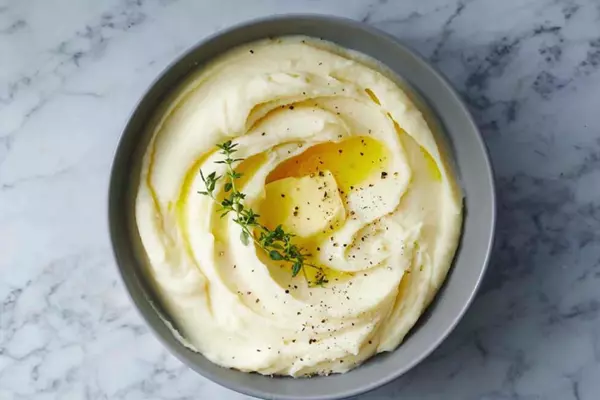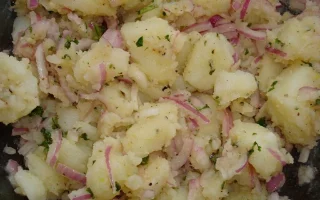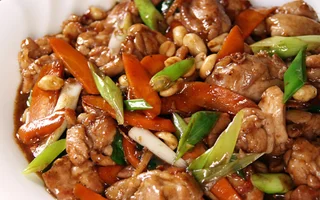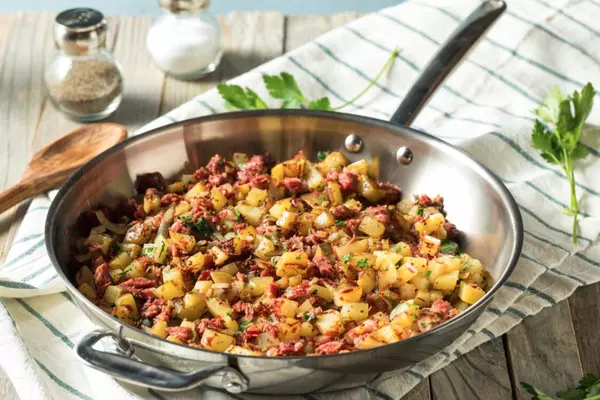How to thicken mashed potatoes? The obvious way to thicken mashed potatoes is by adding some flour, but many other techniques can achieve the same result.
As with all cooking, it’s worth experimenting and trying to find what you like the most.
7 Easy Ways To Thicken Mashed Potatoes
There are a few ways you can thicken up your mashed potatoes:
1. Add More Potatoes
You can add more cooked mashed potatoes to your mixture to help thicken it up. This is a good option if you want to add more flavor or nutrition to your mashed potatoes.
2. Use A Potato Masher Or A Fork
Mashing the potatoes more thoroughly can help break them down the potatoes further, making the mixture thicker.
3. Add A Starch
You can add starch, such as flour or cornstarch, to your mashed potatoes to help thicken them up. Start by adding a small amount (1-2 tablespoons) and gradually add more as needed until the desired consistency is reached.
4. Add Some Dairy
Adding some dairy, such as butter, sour cream, or cream cheese, can help to thicken up mashed potatoes. Start by adding a small amount (1-2 tablespoons) and gradually add more as needed until the desired consistency is reached.
5. Cook The Potatoes Longer
If your mashed potatoes are too thin, you can try cooking them for longer. This can help evaporate some excess moisture, resulting in thicker mashed potatoes.
6. Add Some Cooked, Mashed Vegetables
You can add some cooked, mashed vegetables, such as carrots or parsnips, to your mashed potatoes to help thicken them up. This is a good option if you want to add more flavor and nutrition to your mashed potatoes.
7. Use A Roux
A roux is a mixture of flour and fat (such as butter) that is used to thicken sauces and soups. You can make a roux by melting some butter in a saucepan and then stirring in an equal amount of flour.
Cook the mixture for a few minutes, constantly stirring, until it forms a paste. Then, gradually whisk in some of the hot liquid from your mashed potatoes, stirring until the desired consistency is reached.
How to Thicken Mashed Potatoes
Will Mashed Potatoes Thicken As They Cool?
Mashed potatoes may thicken slightly as they cool, but they will not thicken significantly. If your mashed potatoes are too thin when they are hot, they are likely to remain thin once they have cooled.
To thicken mashed potatoes, you will need to use one of the methods I mentioned in my previous response, such as adding more potatoes, mashing more thoroughly, adding starch or dairy, cooking the potatoes longer, or adding some cooked, mashed vegetables.
What If You Don’t Have Heavy Cream For Mashed Potatoes?
If you don’t have heavy cream on hand, there are a few alternatives you can use in your mashed potatoes:
1. Milk
You can use whole milk, 2% milk, or even skim milk in your mashed potatoes. The higher the fat content of the milk, the richer and creamier your mashed potatoes will be.
2. Half-And-Half
Half-and-half is a mixture of equal parts whole milk and heavy cream. It has a lower fat content than heavy cream, but it will still add richness and flavor to your mashed potatoes.
3. Sour Cream
Sour cream can add a tangy flavor and creamy texture to your mashed potatoes. Start by adding a small amount (1-2 tablespoons) and gradually add more as needed until you achieve the desired consistency.
4. Yogurt
Plain, whole milk yogurt can be used in place of heavy cream in mashed potatoes. It will add a tangy flavor and creamy texture to the dish.
5. Butter
You can use butter to add flavor and richness to your mashed potatoes. Start by adding a small amount (1-2 tablespoons) and gradually add more as needed until you achieve the desired consistency.
6. Cream Cheese
Cream cheese can add a creamy texture and rich flavor to your mashed potatoes. Start by adding a small amount (1-2 tablespoons) and gradually add more as needed until you achieve the desired consistency.
7. Stock Or Broth
If you want to add moisture and flavor to your mashed potatoes without dairy, you can try using chicken, beef, vegetable stock, or broth. Just be aware that this will change the flavor of your mashed potatoes.

Is Milk Or Cream Better For Mashed Potatoes?
Heavy cream is generally considered the best option for mashed potatoes because it has a high-fat content and a rich, velvety texture that can give mashed potatoes a luxurious, creamy consistency.
However, milk can also be used in mashed potatoes and will produce a lighter, less rich result.
The type of milk you use can also affect the flavor and consistency of your mashed potatoes. Whole milk will produce the richest, creamiest mashed potatoes, while skim or low-fat milk will produce a lighter, less rich result.
Ultimately, the choice between using milk or cream in your mashed potatoes will depend on your personal preference and dietary needs.
Heavy cream or whole milk will likely be the best option if you are looking for a rich, creamy consistency.
If you are looking for a lighter, healthier option, you can use lower fat milk or a combination of milk and cream. Top of Form
What Is The Best Milk To Add To Mashed Potatoes?
The best milk to use in mashed potatoes is a matter of personal preference. Whole milk will produce the richest, creamiest mashed potatoes, while skim or low-fat milk will produce a lighter, less rich result.
If you are trying to reduce the fat content of your mashed potatoes, you can use skim or low-fat milk. However, keep in mind that this will result in a lighter, less creamy texture.
You can also use a combination of milk and cream to achieve a balance between richness and lightness.
Do You Put Warm Or Cold Milk In Mashed Potatoes?
It is generally best to use warm milk in mashed potatoes. Adding cold milk to hot mashed potatoes can cause the potatoes to become gummy or lumpy. Warm milk, on the other hand, will help to smooth out the potatoes and create a creamy, cohesive mixture.
Why Do People Add Milk To Mashed Potatoes?
Milk is often added to mashed potatoes to help create a creamy, smooth consistency and to add flavor. The milk helps to break down the potatoes and create a cohesive mixture.
Why You Shouldn’t Use Cold Milk For Mashed Potatoes?
It is generally not recommended to use cold milk in mashed potatoes because it can cause the potatoes to become gummy or lumpy. Cold milk can cause the potatoes to harden and seize up, resulting in a lumpy, uneven mixture.
How Do You Make Mashed Potatoes Fluffier?
There are a few ways you can make mashed potatoes fluffier:
1. Use The Right Potatoes
Starchy potatoes, such as Russets or Idaho potatoes, are the best choice for mashed potatoes because they have a dry, fluffy texture that is well-suited for mashing. Waxy potatoes, such as Red Bliss or new potatoes, have a higher moisture content and may not mash as well.
2. Use The Right Tools
A potato masher or a fork can work well for mashed potatoes, but using a hand-held mixer or a stand mixer fitted with the paddle attachment can produce even fluffier results. Just be careful not to overmix the potatoes, as this can cause them to become gluey.
3. Add Some Air
You can add some air to your mashed potatoes by stirring or mashing them vigorously. This will help lighten the potatoes’ texture and make them fluffier.
4. Use Hot Liquid
Adding hot milk, cream, or broth to your mashed potatoes can help to lighten their texture and make them fluffier. Just be sure to add the liquid gradually and stop when you reach the desired consistency.
5. Add Some Starch
You can add a small amount of cornstarch, flour, or potato starch to your mashed potatoes to help them hold their shape and become fluffier. Just be sure to add the starch gradually and stop when you reach the desired consistency.
Conclusion
Mashed potatoes have a rich, creamy texture that can help to make even the simplest dishes more delicious. Whipping your mashed potatoes with heavy cream will create a luxurious, velvety texture that can add an extra layer of richness and flavor.
However, many mashed potato recipes call for using lower-fat milk and a mixture of milk and cream. This will produce thinner, lighter potatoes with less richness and a drier texture.
- Jet’s Ranch Recipe: Make The Famous Dip At Home - April 12, 2025
- James Hemings Macaroni And Cheese Recipe – History On A Plate - April 3, 2025
- French Dip Squares Recipe – Better Than A Sandwich! - March 25, 2025



1 thought on “How To Thicken Mashed Potatoes: 7 Easy Ways”